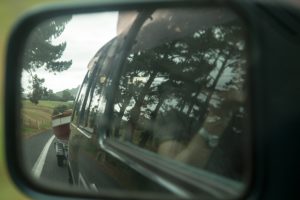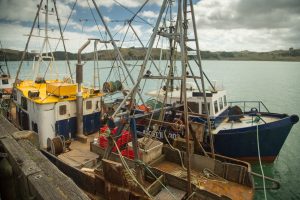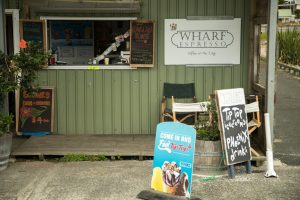Sooner or later, everyone living in New Zealand buys a yacht finally goes sailing for a first time. Sometimes you have to pay to experience this, sometimes you have to work for it on a boat, sometimes you have to do nothing. I was lucky enough cause in my case it was a way easy. Our friend, who has recently left big city and moved into countryside, bought a boat and invited us to go sailing. Yay!

Part seven. “Yawl”
The boat was designed by Paul Fisher, and built in England in 1995 by G L Lindberg.
He bought it from a man in Mahurangi, North of Auckland. He wasn’t the person who shipped her to NZ though. And he doesn’t know who did that. Actually, I don’t think it can be interesting to you. Check this out: blue sky, green hills, beautiful wooden boat. Classic!

When he got it, the boat did not have a name. He knew she was based on an English fishing boat design from the 1860’s, so he looked up what girls’ names were popular at that time (there’s a website for that – of course there is!). He chose “Ruby” and have made a nameplate for her. Ruby on Rails, or Ruby on a trailer, to be precised.
Driving towards Raglan harbour! P.S In New Zeland, speed limit for towing a trailer is 90 km per hour.

As a person who has never been sailing before, I was very interesting how to get boat in the water, how to control it, how to use sail etc. Without knowing specific nautical words and never hearing these words before that was a bit of challenge. And lots of fun.
We didn’t have an introduction to sailing or any training for it. We just went for sailing and hit the ground running as we had to give a help to our friend and follow his commands – pull that rope, push this and so on )

The irony is, some of the nautical terms were borrowed from Dutch, but some of them have their own names or even a few! Will try to explain what I’ve learned in a minute.
Rigging the jib halyard. Jib are all sails at the front of the boat. In our case it has only one, called staysail, which is a triangular sail whose luff can be affixed to a stay running forward from a mast to the deck. A halyard is the rope for pulling up a sail:

Jib and mainsail halyards ‘made off’ on cleats:

Plymouth Belvedere, 1959, 5600!сс – shall I post other pictures or you would rather google for it?

Getting the gaff and boom ready to raise on the mast. Gaff rig is a sailing rig in which the sail is four-sided, fore-and-aft rigged, controlled at its peak and, usually, its entire head by a spar called the gaff.

I think, it make sense to tell you a little bit about the boat.
Yawl – is a two-masted sailing vessel (or one and a half mast, to be precise), whose main mast taller then mizzen mast. Historically, it was a commercial fishing boats, but today, the yawl is a pleasure yacht.
Attaching the throat of the gaff to the mast with parrel beads so that it can slide up and down.

The acknowledged distinction between yawl and other small yachts is that a yawl has the mizzen mast after of the rudder post. Or again, to be precise, after helm port, which is a special hole through the counter of a ship, through which the baller passes. Eh.. I think it’s I’ve just made it even more complicated?
Anyway! We are launching the boat by driving backwards until water lifts boat a bit so you can drive off the trailer.
Also, you can clearly see the whole boat and all it’s mast ready to go:

Rigging the mizzen mast and sail before jumping into the boat and going for sailing. Mizzen mast is a name for the aft-most mast which is typically shorter than the fore-mast:

A view on Raglan wharf, where you can see large commercial vessels after their return from a fishing trip in Tasman sea:

Sailing under the staysail. Enjoying the moment as it is:

Lifejackets are essential for all recreational activities on the water in New Zealand. Everyone on board boats under 6 meters should wear a lifejacket. A skipper, must carry a correctly sized lifejacket for each person on board. If they are not worn, lifejackets must be stored so that they are immediately available in case of an emergency.

The rope, whis is handled by my friend is intended to control staysail position, which is adjusted according the wind direction. In order to control the direction of the boat, you have to use rudder.

Both staysail ropes position can be fixed with a cam cleat:

Mount Karioi, a local landmark I really want to vist at some point and go for hiking. May be this summer?

Once clear of the land, we are getting ready to haul up the main sail:

Lifting the gaff so it’s going up:

The gaff is fully up:


Attaching the boom vang, which prevents the boom from lifting when there is wind in the sail:

The tack of the sail (the corner at the intersection of the mast and the boom):

After we managed to setup mainsail, the speed and the amount of water splashes have drastically increased! ) That was so cool

Also, in addition to standard keel, yawl has a second, false keel which is designed to protect the main keel from damage. The false keel could easily be replaced when it became damaged.
Main keel is a structural element that resembles a fin, cutting water and counteracts the leeward force of the wind, also giving the boat stability as a ballast.
False keel located in a special box, connected with a bottom of the boat and is being lowered when the boat reaches some deep place.
You can also see staysail and two cam cleats:

Then we reached a very calm place we decided to make a stop, have a cup of tea, relax, swim and get some fishing:



Monster from the deep!

At some point weather has changed, so we had to pull out the ancor, adjust the sail and go back to the wharf:

Full speed ahead under outboard:

1963 British Seagull, 2 horse power:

Pulling the boat out of the water. After we got home, we rinsed the trailer with a tap water to avoid its corrosion by the salt water. Basically that is the same reason why you need to avoid driving deep into the sea water on your car. Have you ever been driven at the 90 miles beach at a full speed splashing sea water? )

A few locals approached to me while I was standing in the water nearby the boat, waiting for my friend to come back with a trailer. They were really interested to find out something about the boat so I’ve been asked a few questions:
-Hi, how are you? What’s the name of the boat?
-Good day! Umm.. huhh.. eh..
-What type of boat is that?
-Well.. huhh.. eh..
-I see ))

As result, we decided to park the car on a carpark and get some fish & chips from one of the best fish & chips places in Raglan:




That’s it folks!
Ivan Grigoryev's Blog
Living in New Zealand. Blogging about the country, beautiful places, everyday life.
Do a skydive - halfway completed; get 1400 - still working on; reach 300kph - completed by 96.6%